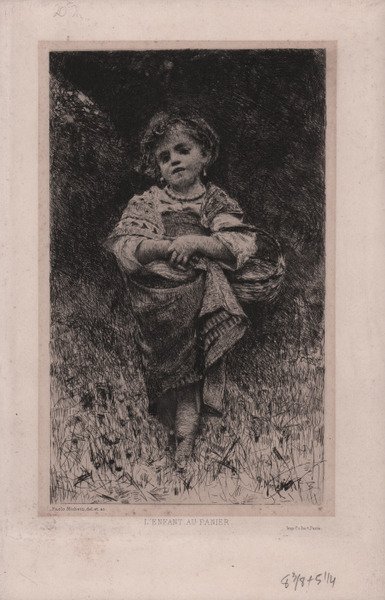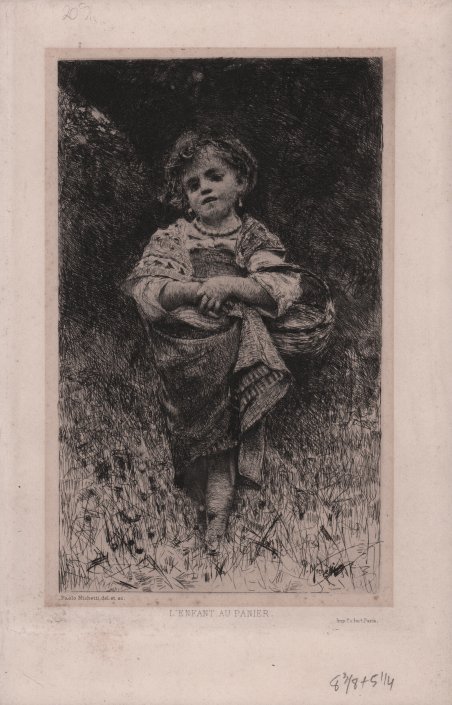Acquaforte, 1880 circa, firmata in lastra in basso. Esemplare nel quinto stato di sei, con l’indirizzo di Cadart. Bellissima prova, impressa su carta vergata coeva, con margini, in buono stato di conservazione. Pittore, incisore e fotografo abruzzese. Si forma presso l’Accademia di Belle Arti di Napoli sotto Domenico Morelli che ne riconobbe immediatamente le doti. L’ambiente napoletano lo spingerà a dedicarsi ad una pittura realista e naturalista grazie anche ai contatti con Filippo Palizzi, Giuseppe De Nittis e Marco De Gregorio, artisti della cosiddetta ' Scuola di Resina. Abbandonata l’Accademia per la troppa rigidità torna in Abruzzo a Francavilla. Nel 1871 parte per Parigi per partecipare ' al Salons, ' apprezzato dal pubblico e dalla critica riesce a farsi conoscere da un pubblico internazionale; a Parigi presso l’editore Cadart vengono pubblicate le quattro lastre che hanno così una tiratura regolare: ' Cueillette d’olives dans les Abruzzes ' 1875, ' L’enfant au panier, ' Gardeuse de dindons, ' Jeunes bergers des environs de Chieti. Le altre quattro lastre note di Michetti ' Tatone, ' Ragazza alla fontana, ' Pastorella abruzzese ' e ' Ritratto di anziano ' sono ad oggi note in pochissimi esemplari. L’incontro con il pittore spagnolo Mariano Fortuny nel 1874 a Napoli favorisce un cambiamento nella tavolozza e lo avvicina a soggetti più folkloristici. Intorno al 1879 risale la sua amicizia, fratellanza con il vate Gabriele d’Annunzio che considera l’artista ' mei dimidium animi. ' Nel cosiddetto ' Conventino, abitazione e studio di Michetti a Francavilla, si riunisce il ' cenacolo michettiano: un’esperienza unica in cui il pittore Michetti, il poeta Gabriele d’Annunzio, lo scultore Costantino Barbella e il musicista Francesco Paolo Tosti – ai quali poi si uniranno altri scrittori ed artisti – lavorarono insieme e sviluppano il tema comune della natura e della gente d’Abruzzo. Una bambina in abiti tradizionali ' incede frontale verso lo spettatore. La figura è in piena luce, si staglia su uno sfondo costituito da una fitta boscaglia, potente è l’uso del chiaroscuro che conosce la lezione di Rembrandt. La bimba ha le braccia appoggiate sul ventre per reggere un cestino, i capelli mossi incorniciano il volto, sembra che stia canticchiando e il particolare degli orecchini e della collana di perle accentuano la luminosità del suo incarnato. Il soggetto è già affrontato in pittura, in particolare nel dipinto ' La Petite Fille au panier ' sul mercato parigino nel 1875 come appartenente alla collezione H. Nel catalogo di venidita il dipinto è illustrato con l’incisone di Michetti che dunque costituisce un termine ante quem di datazione della lastra. La figura è costruita con il tipico segno fine e libero di Michetti, un segno graffiato, elegante; i volumi sono costruiti con un fitto e irregolare intrecciarsi di tratti delicati e punti, morsure successive marcano progressivamente le zone in ombra. Firma nella lastra in basso a destra P Michetti. Nel margine inferiore oltre l’immagine a sinistra “Paolo Michetti del. et sc. “, titolo al centro, a destra “Imp.Cadart, Paris” e a sinistra “Gazzette de Beaux-Arts”. L’esemplare è tratto da ' La Gazette des Beaux-arts ' numero del marzo 1880. Etching, circa 1880, signed in plate at bottom. Exemplar in the fifth state of six, with Cadart's address. Beautiful proof, impressed on coeval laid paper, with margins, in good condition. A little girl in traditional clothes walks frontally towards the viewer. The figure is in full light, stands out against a background of dense brushwood, powerful is the use of chiaroscuro that knows the lesson of Rembrandt. The child has her arms resting on her stomach to hold a basket, the wavy hair frames her face, it seems that she is humming and the detail of the earrings and the pearl necklace accentuate the brightness of her complexion. The subject is already addressed in painting, particularly in the painting La Petite Fille au panier on the Paris market in 1875 as belonging to the H collection. In the sale catalog, the painting is illustrated with Michetti's engraving, which therefore constitutes a terminus ante quem for the dating of the plate. The figure is constructed with Michetti's typical fine and free mark, a scratched, elegant mark; the volumes are constructed with a dense and irregular interweaving of delicate strokes and dots, successive morsure progressively marking the areas in shadow. ' Signature in the lower right corner of the plate P Michetti. In the lower margin beyond the image on the left "Paolo Michetti del. et sc.", title in the center, on the right "Imp.Cadart, Paris" and on the left "Gazzette de Beaux-Arts". ' The copy is taken from La Gazette des Beaux-arts issue of March 1880. Francesco Paolo Michetti (1851 – 1929) learned painting's rudiments from a local ' fresco ' painter. In 1868 he traveled to Naples, supported by a small grant to study at the academy there. Asserting that his temperament would benefit more from real life situations, he was allowed to return to the Abruzzo region in 1869 and continued to receive his grant. Michetti exhibited at the Paris ' Salons ' of 1872 and 1875, but he also belonged to ' Scuola ' di Resina, a group of Neapolitan painters that aimed to bring Italian art into Europe's mainstream. Abruzzo was his emotional and aesthetic inspiration. He captured its people, animals, and local events in emotionally charged paintings with luminous colors and vibrant light. In 1883 Michetti purchased a convent as his home and studio. For the next twenty years, the convent was a meeting place for Abruzzo's artists and exponents of culture, including writer Gabriele D'Annunzio. Michetti's 1895 ' Daughter of Iorioinspired D'Annunzio's 1904 tragedy, for which Michetti designed the sets and costumes. From 1872 onward, Michetti also produced small, decorative clay sculptures. After a lukewarm response to his paintings at the 1900 Exposition Universelle in Paris, he abandoned painting, sold his studio, and generally lived as a recluse. Cfr. Bibliografia: Davoli, 5; Prandi 4 (ill.); V. Bindi, Artisti abruzzesi, Napoli 1883, pp. 172-176; G. D’Annunzio, Nota su F.P. M., in Convito, VIII (1896), pp. 583-592; R. De Logu, Per un profilo di M., in Mostra dei disegni, incisioni e pastelli di F.P. M.


Découvrez comment utiliser
Découvrez comment utiliser

